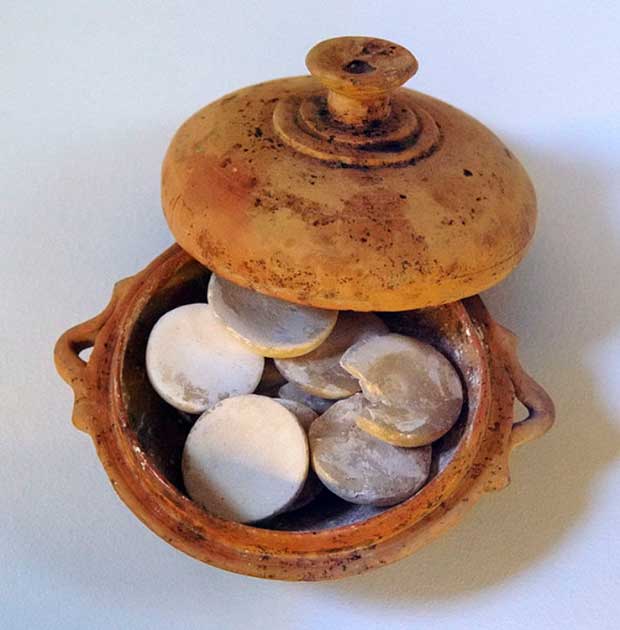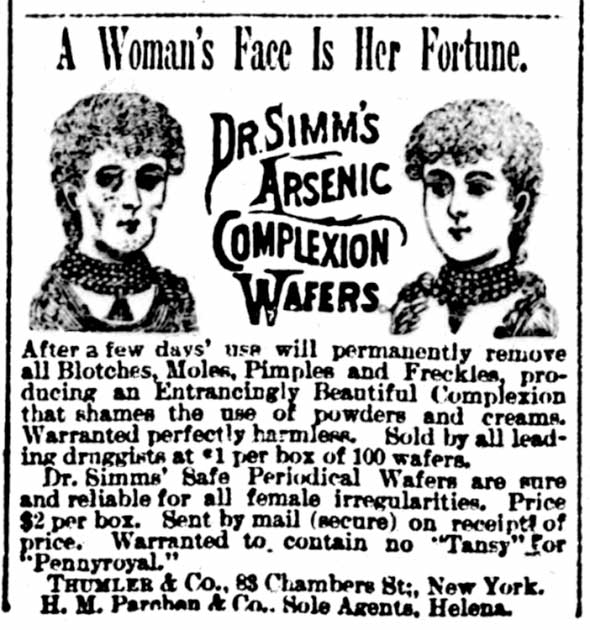Unrealistic standards of beauty have harmed women for centuries across the globe. Women have followed trends such as corsetry which caused fainting and deformity of the rib cage.
Then there was the practice of foot-binding in China, where infants had their feet broken and deformed in pursuit of extreme standards of “beauty”. These are two of the worst measures women have endured to be seen as beautiful. The desire to enhance beauty led to the creation of cosmetics which are still used daily by many women and men today.
The trouble is that these early cosmetic products were often made of incredibly toxic ingredients that had deadly effects on the wearers. Makeup, like medicine, was not regulated for a very long time and contained poisons, radioactive materials, and other toxic ingredients.
In the past, damage to internal and external organs, deformities, and death were caused by makeup. What were some of the ingredients popular in toxic cosmetics that took the saying “beauty is pain” to heart?
Hidden Killers: Lead and Arsenic
Lead-based cosmetic products were incredibly popular from the 15th century through the early 19th century. Venetian ceruse or “Spirits of Saturn” was one of the most notorious lead-containing makeup products.

Ceruse was used to whiten skin and hide blemishes. It was made by dissolving white lead into vinegar to create a paint-like mixture. The ceruse would be applied to the face of both men and women to make them look deathly pale.
Paleness was associated with wealth and high social standing for many years. Paleness indicated that a person did not need to work outside and could hire people to do labor in the hot sun for them.
Lead was one of the most toxic cosmetic ingredients in history. Lead is highly toxic to humans and can result in lead poisoning, as the element can build up in the blood. Some symptoms of lead poisoning include hearing loss, seizures, weight loss, or the development of pica.
Pica is an eating disorder and mental health condition in which someone craves eating non-food items without nutritional value, like chalk, paint chips, or hair. The lead used in makeup in the past also caused skin damage, lowered intelligence, and anemia.
The toxic cosmetic ingredient arsenic, like lead, was used to hide or “remove” blemishes and create a pale skin color. Arsenic was a common ingredient in soaps, powders, and lotions. Women could also eat arsenic wafers to improve the quality of their skin.

Dr. Campbell’s Safe Arsenic Complexion Wafers was a famous brand of arsenic wafers. Many arsenic-containing products marketed themselves as safe or organic, but the truth is that arsenic is incredibly toxic.
- Heroin Cough Medicine? The Rise and Fall of Patent Medicine
- The Poison Squad Trials: Do You Know What’s In Your Food?
Arsenic poisoning can cause vomiting, bloody diarrhea, abdominal pain, encephalopathy, and hair loss. Arsenic also can cause cancer, skin lesions, darkening and thickening of the skin, heart disease, and diabetes.
A person can be exposed to small doses of arsenic over a period of time and survive. However, it can damage the liver and kidney, reduce both red and white blood cells, and lead to stroke and death..
Murderous Mercury and Deadly Nightshade
Mercury was used like arsenic and lead in order to make the skin white, cover up freckles and blemishes, and “blur the aging process.” But mercury wasn’t only used to give women a pallid and sickly-looking complexion. Mercury sulfide was used to create blush/rouges and some early lipsticks.
Cinnabar, a stunningly vibrant orange-red to dark red mineral, was ground down to make a powder to produce a pigment called vermilion. Cinnabar contains high levels of mercury (II) sulfide or mercuric sulfide. It may look good, but it was extremely dangerous.
Mercury is notoriously toxic and has the ability to pass through both a cell’s membrane and the blood-brain barrier. Mercury can damage a person’s nervous system, stomach, kidneys, liver, muscles, skin, thyroid, and adrenal glands. It is also a neurotoxin known to cause brain damage, leading to hallucinations and psychosis.
It was often referred to as “mad hatter’s disease.” Hat makers used to cure felt with a form of mercury, and the mercury vapors’ inhalation over time led to mercury poisoning. Mad hatter’s disease was so prevalent in the hat-making industry that by 1837, the phrase “mad as a hatter” became a common expression. Wearing makeup with high levels of mercury caused exactly the same sort of problems.
A trend in Victorian times was to have wide eyes with dilated pupils to make the eyes replicate a look of love. Women would try to achieve this look by squirting citrus juice into their eyes, but the effect didn’t last very long.
Belladonna, also called deadly nightshade, was perfect for dilating the pupils and lasted far longer than lemon juice. Belladonna is highly poisonous, and the use of deadly nightshade eye drops would cause blurry vision, heart palpitations, vertigo, headaches, hallucinations, and even blindness.
When Beauty Kills
Several notable deaths have been believed to be caused by toxic cosmetics. Although it hasn’t been confirmed, many people believe Queen Elizabeth I of England died due to her infamous white painted face.
It is possible that Elizabeth I used the expensive and popular lead-containing Venetian ceruse to improve her complexion. It is believed that Elizabeth had contracted smallpox which had left her face covered in pockmarks and scars.
Ceruse was used to cover blemishes or hyperpigmentation. As the queen, Elizabeth wanted to appear as healthy as possible and dress in the fashion of the times, with pale white skin. Elizabeth I’s death may have been due to the effects of lead poisoning.

Another ceruse-related death was that of Maria, Countess of Coventry. Maria was famed for her beauty, and to conform to the beauty standards of the time, she would use ceruse to achieve the look of flawless skin. Instead of giving her flawless skin, the ceruse began to cause blemishes which only led Maria to apply more and more ceruse to her face. She died at the age of 27 from lead poisoning from the large amounts of makeup.
Diane de Poitiers, known as “the French mistress who never aged,” was the mistress of King Henry II, who was 20 years her junior. While her official cause of death was complications from a fall, her beauty regimen might have had an impact on her health as well.
When she was exhumed many years later, experts found deadly levels of gold in her hair. Drinkable gold was popular and said to make the drinker look younger.

There was also Agnès Sorel, mistress of King Charles of VII of France. She died when she entered into premature labor with her fourth child and died shortly after. When her body was exhumed by experts in 2005, scientists discovered significant amounts of mercury in her hair which may have caused her early labor and subsequent death.
Is Makeup Safe Today?
In the European Union, as of March 1, 2022, 23 toxic ingredients in cosmetics have been officially banned and can not be used in the production of makeup. The US Food and Drug Administration has banned only 11 ingredients in the United States from being used in cosmetics.
Some of the ingredients banned in the United States include chlorofluorocarbon propellants, chloroform, mercury compounds, and vinyl chloride. While many ingredients have been banned, you can still find many harmful ingredients in cosmetics.
Some of cosmetics’ most widespread harmful ingredients include parabens, phthalates, formaldehyde, and triclosan. Parabens are used to keep cosmetic products free from bacteria and as preservatives. Parabens can mimic estrogen, leading to hormonal imbalances and fertility issues, and can increase cancer risks.
Phthalates are industrial chemicals used to soften some forms of plastic. They are typically found in nail polishes, perfumes, and lotions because they make the product easily spreadable. Phthalates have been linked to attention deficit hyperactivity disorder (ADHD), asthma, breast cancer, type II diabetes, and obesity.
Formaldehyde, a chemical used to preserve animal specimens in laboratories, is used to preserve a cosmetic product and keep it free from bacteria. You can find formaldehyde in nail polish, lotions, deodorants, hair gel, shampoo, and more.
Formaldehyde causes skin irritation as well as burns on the scalp. Formaldehyde has been linked to asthma, cancers, alopecia, and neurotoxicity. Triclosan was created for antibacterial purposes in hospitals and is often found in toothpaste and deodorants. Prolonged exposure to triclosan can result in liver fibrosis, cancer, and impaired immune and muscle function.
To avoid toxic cosmetic products today, there are many websites like the Environmental Working Group’s Skin Deep platform, and apps like Think Dirty can be used to find out the ingredients in cosmetics you own and what is safe to use. There are many organic and “clean” beauty companies today.
If you want to switch to organic products, it is relatively easy. Check for a notice on the packages that say “USDA-certified organic” or “COSMOS Standard.” Many products say they are organic, but if it does not have a certification label, “organic” is likely included to make the product more attractive to buyers. Being aware of the ingredients in cosmetics ensures your safety and reduces the risks of deadly side effects.
Top Image: Queen Elizabeth I famously appeared publicly in pale makeup which would have contained lead. Toxic cosmetics have been worn through history. Source: Philip Mould & Company / Public Domain.
By Lauren Dillon